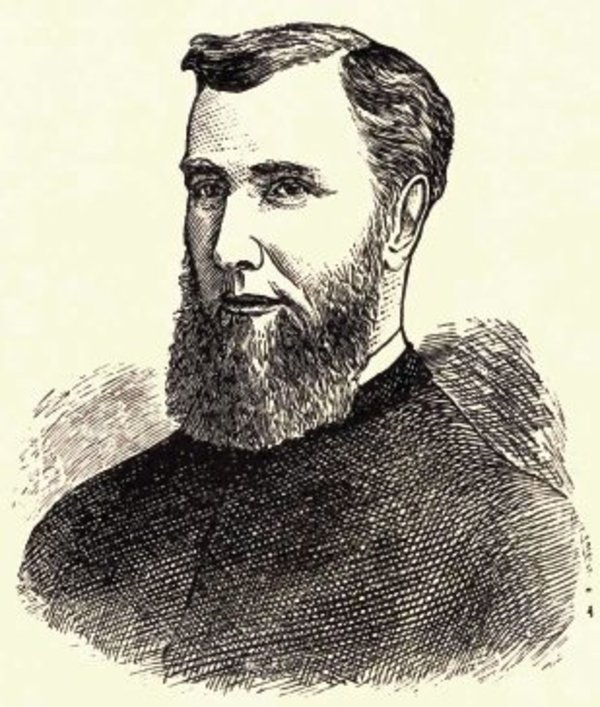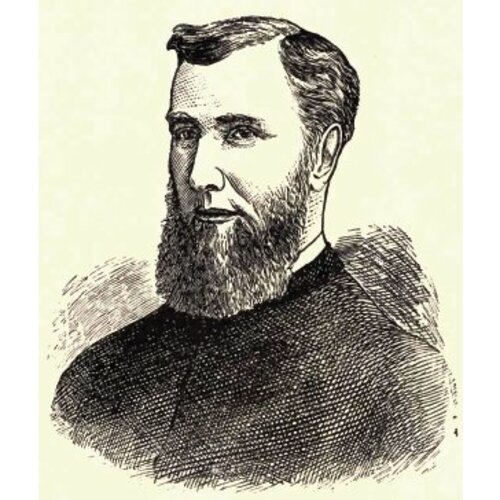
Source: Courtesy of Wikimedia Commons
YOUNG, RICHARD, Church of England clergyman and bishop; b. 7 Sept. 1843, son of Anthony William Young, a merchant, and Mary ——; baptized 4 October in Sculcoates, England; m. 1873 Julia Henstley Harrison, and they had three sons and one daughter; d. 12 July 1905 in Southborough, Kent, England.
Richard Young was educated at Louth Grammar School and at Clare College, Cambridge, from which he received his ba in 1868. Made a deacon that year, he served as curate of Halesowen and, following his ordination as priest on 23 May 1869, he was named vicar of Fulstow. An evangelical churchman, Young developed an interest in missions early in his career. In 1872 he became organizing secretary for the Church Missionary Society in the West Riding of Yorkshire, a role in which he solicited funds for CMS missions throughout the world and recruited young men for mission work. Then, in 1875, he accepted appointment by the CMS to the incumbency of St Andrews (Winnipeg).
In his parish, Young ministered to a population divided equally between settlers of mixed blood and those of purely European origin; in addition, he did mission work among the Saulteaux Indians on a nearby reserve. He also served as an inspector of schools, a member of the board of St John’s College Ladies’ School, and a temperance advocate. Within two years of his arrival he began a long-term campaign to foster among his parishioners a sense of self-sufficiency, so that the parish would support the priest and church instead of relying on grants from the CMS. The effort did not achieve immediate success because parishioners lacked a tradition of providing for church institutions and because successive agricultural failures in the late 1870s imposed great hardship on the community. It would appear, however, that greater financial independence was attained in the early 1880s.
Young was appointed to the finance committee of the diocese of Rupert’s Land in 1877, and he served on it until 1885. The committee was a powerful one. It reported to the CMS on the expenditure of the annual grant to the diocese and dealt with all matters related to the conduct of missions, including the appointment and location of missionaries, the disciplining of personnel, and the study of problems and opportunities in the work. Young’s experience as corresponding secretary (and in reality, controller) of the finance committee prepared him well for future responsibilities as a bishop.
In the early 1880s Bishop William Carpenter Bompas of Athabasca petitioned the CMS to divide his extensive diocese at the 60th parallel. He argued that the expected influx of white settlers into the Peace River district would require the services of a bishop there, and he identifed Young as a candidate for the post. The CMS approved the division in 1882 and the provincial synod of Rupert’s Land acceded in 1883. Young, who had helped monitor the budget of the Athabasca diocese, was asked to undertake a visitation in 1884 to determine the boundaries of the new jurisdiction. It was to cover roughly the northern half of what is now Alberta. Somewhat reluctantly, he accepted elevation to the see, which retained the name Athabasca, on 29 Aug. 1884. On 18 October at St John’s Cathedral, Winnipeg, he became the first Anglican bishop to be consecrated in western Canada. Like Bompas an evangelical, he fitted well into the church’s traditions in the west.
After a tour of England in 1884–86, where he undertook a fund-raising campaign for the new see, the Youngs settled first at Fort Vermilion (Alta) and later at Athabasca Landing (Athabasca). During his 20 years as bishop, Young engaged in a variety of enterprises designed to ensure the survival of the diocese. He worked to make it financially solvent and less dependent upon the CMS. With this aim in mind he petitioned the commissioner of Indian Affairs for funds to support the five or so mission schools. He continued diocesan synods on a regular basis (every three to four years) and conducted frequent visitation of the various missions, from Fort Dunvegan (Dunvegan) in the west to Fort Chipewyan in the north to Wabasca and Lesser Slave Lake in the south. When missionaries were on furlough, he substituted for them.
From the outset of his episcopate Young saw the mission to the aboriginal peoples, including the mixed-blood population, to be the “first & most important object of all our efforts.” In 1892 he established a printing-press to publish the Scriptures and other religious works in Cree and Beaver syllabics. He encouraged his priests to study the Cree, Beaver, and Slavey languages and endeavoured, though unsuccessfully, to learn them himself. Generally sympathetic to the native people, he criticized the dominion government’s lack of sincerity in its dealings with them, particularly in the treaty negotiations of the 1880s and 1890s. He condemned the inadequate provision it made for their education and, recalling Manitoba, opposed the issue of scrip for lands. Despite his sympathy, he viewed the creation of a native clergy with some scepticism, even though it was CMS policy. He had thought that the mixed-blood members of his congregation at St Andrews suffered from their native heritage, and he believed that the Cree, Slave, and Beaver Indians of Athabasca had been corrupted by their contacts with white traders. As late as 1900 he remarked that the “unsettled” conditions of native life were unfavourable to the establishment of “a self-supporting and self-governing church.”
The number of conversions to the Church of England was small during Young’s tenure as bishop, probably because of his stringent requirements for baptism and confirmation, but likely also because of the competition offered by the Roman Catholic Church. In common with many of his Protestant colleagues, he was stridently anti-Catholic, and he waged an ongoing struggle against what he regarded as incursions by Catholic missionaries into his diocese [see Isidore Clut]. Although his career was not marked by any radical departures in policy or new initiatives in evangelism, he did lay the foundations for missions and churches throughout his diocese. He resigned on 31 Dec. 1903 on account of ill health and retired to England, where he died a year and a. half later.
Hereford and Worcester County Record Office (Worcester, Eng.), Ordination papers of Richard Young as deacon, 1868, enclosing copy of baptismal record (Sculcoates, Yorkshire, RBMB, 4 Oct. 1843). Lincolnshire Arch. (Lincoln, Eng.), LOUTH G S C/I/2 (Louth Grammar School records), 1853–57. NA, MG 17, 132, C, C.1/O, Young to Wright, 18 June 1877, 21 Feb. 1880; Young to Fenn, 26 Nov. 1879; G, C.1/O, Bompas to Church Missionary Soc., 16 May 1882 (mfm.). Provincial Arch. of Alberta (Edmonton), ACC, Diocese of Athabasca records, A.280–81. Edmonton Bulletin, 14 July 1905. Canadian men and women of the time (Morgan; 1898). C. H. Mockridge, The bishops of the Church of England in Canada and Newfoundland . . . (Toronto, 1896). O. R. Rowley et al., The Anglican episcopate of Canada and Newfoundland (2v., Milwaukee, Wis., and Toronto, 1928–61).
Cite This Article
Michael Owen, “YOUNG, RICHARD,” in Dictionary of Canadian Biography, vol. 13, University of Toronto/Université Laval, 2003–, accessed December 31, 2025, https://www.biographi.ca/en/bio/young_richard_13E.html.
The citation above shows the format for footnotes and endnotes according to the Chicago manual of style (16th edition). Information to be used in other citation formats:
| Permalink: | https://www.biographi.ca/en/bio/young_richard_13E.html |
| Author of Article: | Michael Owen |
| Title of Article: | YOUNG, RICHARD |
| Publication Name: | Dictionary of Canadian Biography, vol. 13 |
| Publisher: | University of Toronto/Université Laval |
| Year of publication: | 1994 |
| Year of revision: | 1994 |
| Access Date: | December 31, 2025 |



